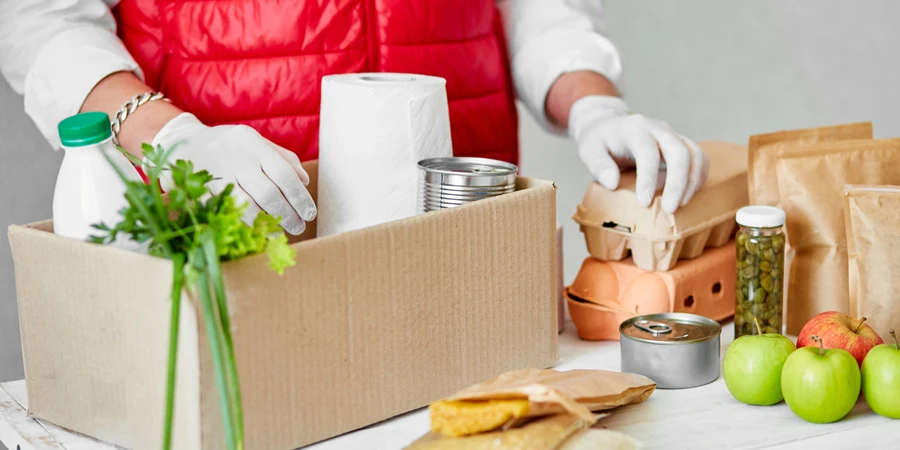In the vast supply chain, controlling perishable goods proves elusive, risking product quality, customer satisfaction, and brand reputation.

As consignments of perishable goods move between buyers and suppliers, it’s difficult to maintain complete control and oversight of their condition.
The process of transporting goods comes with its fair share of challenges in its own right. Still, it’s almost impossible to be fully cognizant of whether all items remain intact and in optimal condition, particularly if they are carried between multiple intermediaries and shipment carriers. What’s more, external and environmental factors – which largely fall out of both suppliers’ and buyers’ hands – can diminish product quality and cause delivery delays.
Ultimately, dented shipment packages, missed timescales, and goods in poor condition – or a hybrid of all of them – can drastically affect customer satisfaction and continued loyalty. Trust and reputation carry immense weight in global supply chains, and it’s in suppliers’ best interests to ensure that they can mitigate as many of the inherent transit risks as possible.
Fortunately, in today’s climate where transparent sustainability is more vital than ever, finding innovative ways to make product shipments more sustainable can – bilaterally – better protect perishable goods. Implementing sustainable packaging solutions tailored for different items can help prevent items from being damaged in the first place.
What causes perishable goods to suffer damage or deterioration?
Depending on the packaging that has been used in your shipping consignment, the fragility of the goods being shipped, and the environments through which they are being delivered, damage can occur at varying degrees.
See Also:
- Chocolates Valor chooses Sonoco’s GREENCAN for cocoa packaging
- ProAmpac to show sustainable packaging solutions at Packaging Innovations
Of course, goods can be damaged for a multitude of reasons, with a combination of the following seemingly most likely:
- Temperature fluctuations and spikes
- Excessive moisture and condensation
- Shocks and vibrations
- Poorly secured containers
- Inadequate or unsustainable packaging
Transporting perishable goods via air or sea is usually very controlled, involving a mixture of refrigeration chambers, dry dock surveys and maintenance, insulation processes, and others.
Ultimately, it’s in the whole planet’s best interest to tackle this, as it contributes to global food waste amounting to 8-10% of global greenhouse gas (GHG) emissions and 3.3 billion tonnes
It’s important to remember that there are issues that suppliers cannot control, but if consignments regularly fail, it might be worth reassessing what needs improvement that falls within their remit. That often starts by looking at packaging and finding a more sustainable alternative to prevent these issues from materialising.
Preventing temperature fluctuations and condensation
Maintaining consistent cool or frozen temperatures is crucial when transporting perishables. Allowing contents to heat up and cool down repeatedly encourages spoilage and condensation build-up which can ruin packaging integrity.
Using high-quality insulated or cold storage containers tailored to shipment size will be a great way to start, rather than wrapping goods in thin materials that do little or nothing to prevent them from succumbing to the elements and varying temperatures. At a micro level, it would be worth investing in eco-insulated shipping boxes which can come in recyclable and degradable materials like cardboard. Placing cooling packs inside them can help to maintain low temperatures over an extended period, depending on transit times.
Sealing perishables in a waterproof impermeable film will also help perishable goods to withstand a broad range of temperatures. Suppliers can often source vapour-permeable and vapour-proof film for a variety of different substrates, all of which are environmentally friendly and recyclable.
Cushioning against shocks and vibrations
Accidents can happen during handling and transit, and while they’re rare, they can have a profound effect on the quality and integrity of perishable goods.
Goods processed en masse can suffer excessive vibrations or instant jolts which can cause storage containers or packaging to split, break, or fall from height. At this point, the goods could succumb to immense temperature spikes, or the force of a sudden impact could also spoil them before they’ve even reached their destination. Even if routes have been planned and optimised strategically, taking preventative steps to minimise damage will provide greater long-term peace of mind.
A proactive workaround would be to invest in bespoke moulded pulp products, which make great and stable alternatives to plastic. This protective eco-packaging can be moulded to any shape, meaning that each item is securely cushioned by a firm, protective – and recyclable – layer.
Air cushions provide additional cushioning for goods in transit, with the inflated air demonstrating good compressive strength and flexibility. They can often be used to fill gaps between perishable goods in packages and can come in a range of shapes and sizes. Contrary to popular belief, they are usually made from recyclable or biodegradable materials like HDPE film, meaning they can be recycled and offer additional stability from excessive external pressure.
Minimising exposure to oxygen, moisture or light
Some perishables like meat and dairy products degrade quickly when exposed to direct light, excessive moisture and oxygen. If transporting these, it would be worth investing in specific protective products to prevent direct exposure.
Modified Atmosphere Packaging (MAP) is a great way to preserve food products and maintain a longer shelf life. This packaging uses a single or hybrid of gases to create protective environments for the food, which, when combined with suitable packaging materials and lowered temperatures, keeps food fresher for longer. This is often preferred to other methods like skin or vacuum packaging for certain products.
Silica gel is another known desiccant and drying agent widely used in small packages to prevent moisture ingress. Some silica gel sachets work autonomously to absorb and remove humidity in sealed packages to prevent excessive condensation, dampness, or mould.
Degradable and recyclable materials
While durability is important in transit, sustainable factors like using renewable, recyclable and biodegradable materials cannot be overlooked. It just so happens that using renewable packaging materials can help reduce the impact of environmental damage or spoiling, thus increasing the chances of successful deliveries and keeping buyer relationships intact.
Bagasse is a fibrous material made from sugarcane pulp, offering a much more sustainable option than conventional plastic and polystyrene. Sugarcane can be harvested far more quickly than trees, making it rapidly more renewable, while still being compostable and degradable. Over time, it becomes a nutrient-rich compost that can be put back into the earth.
Bioplastics (such as Polylactic Acid) made from cornstarch or hemp can be used as more stable and reliable products usually made from soft or hard plastic. The material itself is biodegradable and carbon neutral, offering a more environmentally friendly option than plastics that rely on fossil fuels and excessive greenhouse gas (GHG) emissions. Suppliers relying heavily on plastic should consider switching to this eco-friendly alternative imminently.
The ban on Russian birch and birch plywood as packaging materials has prompted European producers to seek alternatives from sustainably managed forests and plantations (SMF&P). Poplar, predominantly situated in the Mediterranean, can be produced in large volumes and has an inherently faster growth cycle. Packaging materials made from standard timber can achieve a better carbon footprint and life cycle if using a certified product like poplar.
With rising consumer expectations on sustainability, deploying green packaging materials tailored for individual perishable items offers new opportunities for eco-conscious brands to build customer loyalty while demonstrating environmental commitments.
About the author: Annie Button is a freelance writer based in the UK. She specialises in business development, sustainability, digital trends, marketing, and HR.
Source from Packaging Gateway
Disclaimer: The information set forth above is provided by packaging-gateway.com independently of Alibaba.com. Alibaba.com makes no representation and warranties as to the quality and reliability of the seller and products.




